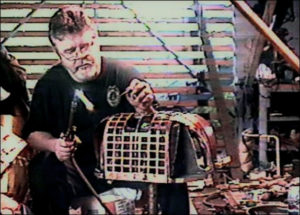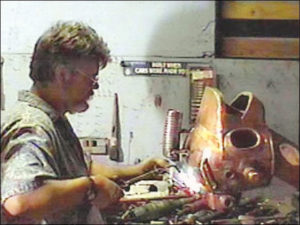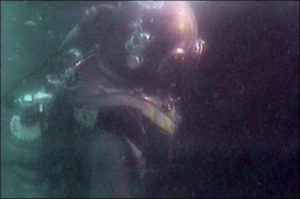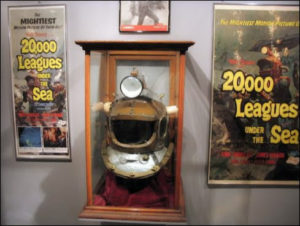Diving 20,000 Leagues with Pat Regan of Vulcania Submarine
It’s funny how things come together. Little bits and pieces come to light, and over time those bits join together to finally form something truly remarkable. That’s the way Vulcania Submarine and Aquala’s “20,000 Leagues Under the Sea” project came to life. Little bits here and there, to form something that hadn’t been accomplished in over 50 years.
It all started a few years before I purchased Aquala, sometime around 1999. Me, always having a love of diving and everything under the sea, had a wild idea to build my own submarine. The internet was in its infancy in those days, but it didn’t take enthusiasts long to form groups to discuss topics of interest. The home-built submarine community was no different. After a few searches on AltaVista and by “Asking Jeeves” (remember those?), I found such a community. It was a fascinating place where professional marine engineers, as well as backyard welders and designers, came together to share ideas and build functional, diveable, miniature submarines.

Pat “Keep On Leaguin” Regan
If you ever run into Pat, he’s likely one of the most colorful people you’ll ever meet. He’s a USMC Vietnam veteran, martial artist, pilot, skydiver, biker, diver, welder, songwriter, musician, author, screenwriter, retired corrections officer, and most importantly for this story...a “Leaguer”. What’s a “Leaguer”? Leaguers are fans and enthusiasts of all things Disney’s “2000 Leagues Under the Sea”. When it comes to Leaguers, Pat definitely leads the pack.
In one of our forum exchanges, I told him that by default I was somewhat of a Leaguer since Aquala had originally produced the suits for Disney in 1954. Pat thought it was cool and mentioned that he’d toyed with the idea of making a fiberglass replica of Nemo’s helmet. I told him if he ever decided to build the real thing in metal, that I could build the suit. It was an intriguing idea, but everything had to be relearned about the diving systems first, as that information had been lost to the years.
In addition to all of Pat’s credentials previously mentioned, I should have also mentioned “researcher”. You see Pat took “20,000 Leagues” research to the next level by not only combing through vintage photos and behind-the-scenes film stills from 1954, but also by building and testing various methods of aspirating a diving helmet until he figured out how Disney's apparatus worked.

Pat working the metal.
With all of that information in our coffers, Pat and I went to work.
Pat began cutting, shaping, and soldering copper.
I began cutting, shaping, and bonding rubber.

Ty working on the suit.
After months and months, Pat had a functioning concept. While waiting for me to perfect the suit, he began testing the helmet.

Pat’s “Lo-quala” test jacket.
From a military surplus tarp and some foam rubber, he crafted a homemade diving jacket which he dubbed the “Lo-quala”.
Sure the quality was low, but it served its purpose. He rediscovered the esoteric technologies Disney's stunt divers had used, and so onward he marched.
During Pat’s arduous research, he also discovered all of the other details and aspects of the League’s rigs. He decided to create those too. He pulled out all of the stops by recreating the boots, the harness, the tank pack, and shroud, and even found the correct belt knife. Everything was as it would have been on that Disney barge in the Bahamas, where the 1954 underwater scenes were filmed.

Testing the breathing system.
The World's first replica “Nemosuit” was ocean-dived in August of 2003 at Keauhou, Hawaii; much in the same way Jules Verne would have imagined Captain Nemo himself testing the system when he originally wrote “20,000 Leagues” back in 1870. It wasn’t long after this dive that a replica "crowntop" Crew Diver helmet was under construction, and Pat's Vulcania Submarine Display was at the 20,000 Leagues Expo in Anaheim, California. It was there that it was seen by Disney Stunt Diver Bill Stropahl, and a friendship began that exists to this day.

Featured in the Museum of Diving History in Florida.
Having drawn national and international attention to his work, Pat was asked if he would sell his helmet. Sure he was reluctant, but if he could build one, why not build a few more? In 2004 he sold that first Nemo helmet to the Museum of Diving History in Islamorada, Florida where it remains the centerpiece of their “20,000 Leagues” display. Once sold, he went back to work on the Nemo 2, which subsequently went to the private collection of one of Pat’s good friends.
By 2007 Pat had built his third Nemo and completed his first functional crowntop replica. Soon a complete diveable crew rig was built, and Pat again had done what hadn’t been done since Disney. He had the beginnings of a Nautilus diving locker, and I went to work crafting a crewman’s suit.
The crewman’s suit was an interesting project which took several years to develop because when you watch the movie, the color of the suits changes from scene to scene. Sometimes they appear green, sometimes they appear olive, and other times brown. Which was it? We knew that old color film could be deceptive, along with the lighting and filters used on set, so we went with what made sense at the time. The first suit I built was standard Aquala water-green, but later we decided the original suits were likely closer to an olive green. That required a new order of olive rubber material to be made, and once it arrived, an olive green suit was added to the crew locker.
With 53 years between us and the originals, and after years of exhaustive research, it was time to put it all together. It was time to do what these systems were designed for, and it was definitely time to take a dive.
To be continued...
Great story, and very interesting how it all came together.
I’m lucky enough to have one of the original crown tops in my collection.
Pat and I, have had a good email relationship for some years now, and he just sent me your article.
Thanks Leon, glad you enjoyed the story!